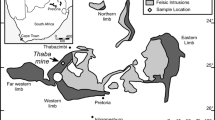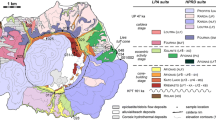Abstract
Metagabbros from two widely separated areas in the Adirondacks show development of coronas. In the Southern Adirondacks, these are cored by olivine which is enclosed in a shell of orthopyroxene that is partially, or completely, rimmed by symplectites consisting of clinopyroxene and spinel. Compositions of the corona phases have been determined by electron probe and are consistent with a mechanism involving three partial reactions, thus:
-
(a)
Olivine=Orthopyroxene+(Mg, Fe)++.
-
(b)
Plagioclase+(Mg, Fe)+++Ca++=Clinopyroxene+Spinel+Na+.
-
(c)
Plagioclase+(Mg, Fe)+++Na+=Spinel+more sodic plagioclase+Ca++.
Reaction (a) occurs in the inner shell of the corona adjacent to olivine; reaction (b) in the outer shell; and (c) in the surrounding plagioclase, giving rise to the spinel clouding which is characteristic of the plagioclase in these rocks. Alumina and silica remain relatively immobile. These reactions, when balanced, can be generalized to account for the aluminous nature of the pyroxenes and for changing plagioclase composition. Summed together, the partial reactions are equivalent to:
-
(d)
Olivine + Anorthite = Aluminous orthopyroxene + Aluminous Clinopyroxene + Spinel (Kushiro and Yoder, 1966).
In the Adirondack Highlands, coronas between olivine and plagioclase commonly have an outer shell of garnet replacing the clinopyroxene/spinel shell. The origin of the garnet can also be explained in terms of three partial reactions:
-
(e)
Orthopyroxene+Ca++=Clinopyroxene+(Mg, Fe)++.
-
(f)
Clinopyroxene+Spinel+Plagioclase+(Mg, Fe)++=Garnet+Ca+++Na+.
-
(g)
Plagioclase+(Mg, Fe)+++Na+=Spinel + more sodic plagioclase+Ca++.
These occur in the inner and outer corona shell and the surrounding plagioclase, respectively, and involve the products of reactions (a)-(d). Alumina and silica are again relatively immobile. Balanced, and generalized to account for aluminous pyroxenes and variable An content of plagioclase, they are equivalent to:
-
(h)
Orthopyroxene+Anorthite+Spinel=Garnet (Green and Ringwood, 1967).
Amphibole coronas about opaque oxides in rocks of both areas are the result of oxide/plagioclase reactions with addition of magnesium from coexisting olivine.
Based on published experimental data, pressure and temperature at the time of corona formation were on the order of 8 kb and 800° C for the garnet bearing coronas, with somewhat lower pressures indicated for the clinopyroxene/spinel coronas.
Similar content being viewed by others
References
Carmichael, D. M.: On the mechanism of prograde metamorphism reactions in quartzbearing pelitic rocks. Contr. Mineral and Petrol. 20, 244–267 (1969).
Green, D. H., Hibberson, W.: The instability of plagioclase in periotite at high pressures. Lithos. 3, 209–221 (1970).
Green, D. H., Ringwood, A. E.: An experimental investigation of the gabbro to eclogite transformation and its petrologic applications. Geochim. Cosmochim. Acta 3, 767–834 (1967).
Griffin, W. L.: Genesis of coronas in anorthosites of the upper Jotun Nappe, Indre Sogn, Norway. J. Petrol. 12, 219–243 (1971).
Irving, A. J., Green, D. H.: Experimental duplication of mineral assemblages in basic inclusions of the Delegate breccia pipes. Phys. Earth Planet. Inter. 3, 385–389 (1969).
Kretz, R.: Distribution of magnesium and iron between orthopyroxene and calcic pyroxene in natural mineral assemblages. J. Geol. 71, 774–785 (1963).
Kushiro, I., Yoder, H. S., Jr.: Anorthite-Forsterite and Anorthite-Enstatite reactions and their bearing on the basalt-eclogite transformation. J. Petrol. 3, 337–362 (1966).
McLelland, J. M.: Structure and stratigraphy of the southernmost Adirondacks. New England Intercollegiate Geological Conference Guidebook, 1969 Meeting, p. 11–1–11–34 (1969).
Saxena, S. K.: Silicate solid solutions and geothermometry 4: Statistical study of chemical data on garnets and clinopyroxenes. Contr. Mineral. and Petrol. 23, 140–156 (1969).
Simmons, G.: Gravity survey and geological interpretation, northern New York. Bull. Geol. Soc. Am. 75, 82–98 (1964).
Waard, D. de: Absolute P-T conditions of granulite facies metamorphism in the Adirondacks. Koninkl. Ned. Akad. Wetenschap., Proc., Ser. B, 70, 400–410 (1967).
Whitney, P. R.: A layered intrusion near Jay Mountain New York. Abstracts with Programs, Geol. Soc. Am., Northeast Section Meeting, p. 51 (1972a).
Whitney, P. R.: Spinel inclusions in plagioclase of metagabbros from the Adirondacks Highlands. Am. Mineralogist in press (1972b).
Author information
Authors and Affiliations
Additional information
Published by permission of the Director, New York State Museum and Science Service, Journal Series No. 144.
Rights and permissions
About this article
Cite this article
Whitney, P.R., McLelland, J.M. Origin of coronas in metagabbros of the Adirondack mts., N. Y.. Contr. Mineral. and Petrol. 39, 81–98 (1973). https://doi.org/10.1007/BF00374247
Received:
Issue Date:
DOI: https://doi.org/10.1007/BF00374247




